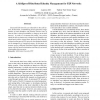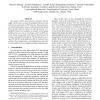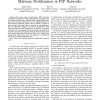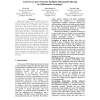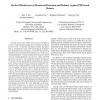COLCOM
2007
IEEE
14 years 9 months ago
2007
IEEE
—Recently, unstructured peer-to-peer (P2P) applications have become extremely popular. Searching in these networks has been a hot research topic. Flooding-based searching, which ...
CISIM
2007
IEEE
14 years 9 months ago
2007
IEEE
Peer-to-peer (P2P) topology has significant influence on the performance, search efficiency and functionality, and scalability of the application. In this paper, we propose a P...
ISCC
2008
IEEE
14 years 9 months ago
2008
IEEE
Structured P2P networks are vulnerable to the sybil attack. In this attack, a misbehaving person generates a huge number of node identifiers and possibly chooses some of them in ...
IPPS
2008
IEEE
14 years 9 months ago
2008
IEEE
Peer-to-peer (P2P) networks based on consistent hashing functions have an inherent load uneven distribution problem. Things are even worse in unstructured P2P systems. The objecti...
ICYCS
2008
IEEE
14 years 9 months ago
2008
IEEE
P2P worms pose heavy threatens to P2P networks. P2P worms exploit common vulnerabilities in member hosts of a P2P network and spread topologically in the P2P network, a potentiall...
ICDCS
2008
IEEE
14 years 9 months ago
2008
IEEE
Peer-to-peer (P2P) data networks dominate Internet traffic. In this work, we study the problems that arise when mobile hosts participate in P2P networks. We primarily focus on th...
ICC
2008
IEEE
14 years 9 months ago
2008
IEEE
—The recent surge of peer-to-peer (P2P) networks consisting of thousands of of hosts makes them a breeding ground for malware proliferation. Although some existing studies have s...
HICSS
2008
IEEE
14 years 9 months ago
2008
IEEE
Many peer-to-peer (P2P) networks have been widely used for file sharing. A peer acts both as a content provider and a consumer, and is granted autonomy to decide what content, wit...
INFOCOM
2009
IEEE
14 years 9 months ago
2009
IEEE
—Peer-to-peer (P2P) file distribution is a scalable way to disseminate content to a wide audience. For a P2P network, one fundamental performance metric is the average time need...
DSN
2009
IEEE
14 years 10 months ago
2009
IEEE
Recently, peer-to-peer (P2P) networks have emerged as a covert communication platform for malicious programs known as bots. As popular distributed systems, they allow bots to comm...

